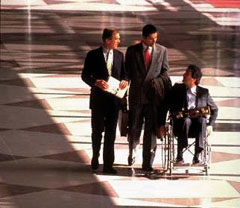Surveying Your Hotel
Don’t make the mistake of assuming your designated “handicap rooms” are ADA compliant. Whereas these accessible guest rooms most likely have been renovated within the past 20 years since the ADA was passed, these renovations may have made elements within the rooms inaccessible. Since ADA compliance is measured in fractions of inches, surveying for accessibility is critical. Once a room is labeled as “handicapped” or “accessible,” the actual accessibility elements may be overlooked.
You should not wait until March 15, 2012 to identify existing barriers, but begin now to evaluate your facility and develop priorities for removing barriers. A thorough evaluation and barrier removal plan, developed in consultation with the disability community, can save time and resources.
Hotel facilities should ensure their survey of accessible elements includes the following:
-
You must provide accessible parking spaces for cars and vans. An accessible parking space must have an access aisle, which allows a person using a wheelchair or other mobility device to get in and out of the car or van.
-
If the main entrance cannot be made accessible, an alternate accessible entrance can be used. If you have several entrances and only one is accessible, a sign should be posted at the inaccessible entrances directing individuals to the accessible entrance. This entrance must be open whenever other public entrances are open.
-
The path your customer with a disability takes to enter and move through your hotel is called an "accessible route." This route, which must be at least three feet wide, must remain accessible and not be blocked by items such as vending or ice machines, newspaper dispensers, furniture or potted plants.
-
You must also ensure that no new barriers are created that impede access by customers with disabilities. For example, routinely piling snow in accessible parking spaces makes them unusable and inaccessible to customers with mobility disabilities.
-
Make sure your hotel has the required number of accessible rooms, including rooms with communication features.
-
Accessible rooms must be dispersed among the various classes of sleeping rooms accommodations that include room size, bed size, cost, view, fixtures such as hot tubs and spas, and smoking/nonsmoking. Wheelchair-accessible sleeping rooms with roll-in showers are required by the standards.
-
Fire alarm or other emergency warning system for individuals who are deaf or hard of hearing.
-
Accessible pathways, approaches to elements and turning space for wheelchairs.
-
If carpeting is provided, ensure it is low-pile, tightly woven and securely attached.
-
Handles and dispensers that can be operated easily with one hand.
-
Tub and shower seats that can be securely attached.
-
Accessible dispensers and operating controls within reach ranges.
-
Accessible light switches, thermostats, drapery wands and door security hardware; and accessible sinks and toilets with grab bars.
-
An accurate and reliable reservation system to provide persons with disabilities the ability to reserve rooms with accessible amenities.
You should take action now to survey your guest rooms for ADA compliance with the 1991 standards and begin to implement the new 2010 requirements for reservation systems and communication features. These actions will increase your protection against ADA liability.


